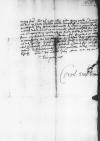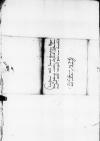Miror, quod per novisimum cursorem nihil ad me scripseris, cum orig. quum⌈cumcum orig. quum⌉ ego ex ⌊Monoeco⌋ et prius ex Celtiberis[1] abunde orig. habunde⌈abundeabunde orig. habunde⌉ omnia ⌊⌋, quae nos concernunt. Interea nihil dignum scriptu occurrit, namque agimus hic in angulo ⌊Liguriae⌋, unde vix licet pedem explicare ob ⌊Gallorum⌋ ⌊Venetorum⌋que vires, quae terra marique nunc dominantur. Exercitus noster aut ⌊Romae orig. Rhomae⌈RomaeRomae orig. Rhomae⌉⌋ agit, aut adhuc in ⌊Campanicis⌋ deliciis sine duce, sine stipendio, eo insolentior, quo ditior et onustior praeda orig. preda⌈praedapraeda orig. preda⌉, addam etiam, et segnior. ⌊Antonius de Leyva⌋ ⌊Insubriam⌋[2] tuetur, in quam ⌊Helvetii⌋ Gallico stipendio conducti iam, ut fama est, aut descendere, aut sane, ut descendant, vicini sunt, praemissis orig. premissis⌈praemissispraemissis orig. premissis⌉ impedimentis ⌊Vercellas⌋ in patriam ⌊magni cancellarii nostri⌋. Quae res nobis adimit omnem potestatem eo contendendi. Ideoque pendemus animi, exspectantes iussum mandatumque ⌊caesaris⌋. ⌊Pontifex Romanus orig. Rhomanus⌈RomanusRomanus orig. Rhomanus⌉⌋ iam capite diminutus, incertum, an ⌊Romae orig. Rhomae⌈RomaeRomae orig. Rhomae⌉⌋, an ⌊Caietae⌋ servetur. Nam in hac regionum vicinia plena omnia sunt mendaciorum. Copiae nostrae, quae partim sub ductu auspiciisque ⌊Anthonii⌋, partim sub signis ⌊comitis Lodroni⌋ militant, tam propinquae sunt ⌊Venetis⌋, ut vix ad duo milia orig. millia⌈miliamilia orig. millia⌉ passuum intercedere putent, quominus manus conserant. Magno animo nostri ⌊Venetos⌋ contemnunt, quod nescio, quam faciant prudenter, saepe orig. Sepe⌈saepesaepe orig. Sepe⌉ enim contemptus hostis nocuit. Sed ⌊Anthonius⌋ nihil diff remorari victoriam de ⌊his⌋ ait, quam quod pecunia in stipendium militi desit, adeo non habet rationem tantarum expilationum, quae a crudelissima gente in misera ⌊Insubria⌋ perpetratae sunt. Et haec quidem sunt, quae pro tempore scribenda occurrunt. Namque aliud nihil habemus, postquam a sacra ⌊caesarea maiestate⌋ certiores facti fuerimus, quid nobis agendum o written over ...⌈... illegible⌈...... illegible⌉oo written over ...⌉mittendumve sit, facile ex me rationem vivendi nostram rescies. Interea me omnibus commenda.
Rex Bohemiae encrypted ⌈Rex BohemiaeRex Bohemiae encrypted ⌉[3] omnem penitus Hungariam encrypted ⌈⌊Hungariam⌋Hungariam encrypted ⌉ spe vocat. Multa hic narrantur de rebus Hungaricis. Aiunt nescio quem ⌊terrae filium⌋, qui se Ioannem Caesarem a Deo missum vocat, istic orig. isthic⌈isticistic orig. isthic⌉ prodiisse cumque eo ex terra subito erupisse dena milia armatorum. Ego, cum orig. quum⌈cumcum orig. quum⌉ haec audio, incipio dubitare, an falsa sit dentium draconis ab ⌊Iasone⌋ facta seminatio, paulatimque accidet ⌊Deucalion⌋ et ⌊Cadmu written over o⌈ouu written over o⌉s⌋.[4] Namque haec si in ⌊Hungaris⌋ fiant, an dubitare possumus illa superinscribed⌈illailla superinscribed⌉ in ⌊Graecia orig. Grecia⌈GraeciaGraecia orig. Grecia⌉⌋ accidisse? Oro te per amicitiam nostram, ut, si quid habeas comperti, ad me scribas. Nam multi, quid de hac re sentiam, perconctantur. Neque deest fortassis mihi et mea quoque opinio, neque iudicii adhuc sum tam hebetis et obtusi, ut quicquam existimem tale evenire potuisse, cum minime iam opus sit homines ex lapidibus nasci, cum tantum ubique sit mulierum. Circumferuntur ⌊ipsius⌋ litterae ad proceres ⌊regni Hungarici⌋ scriptae ingenio sane nullo adeo, ut nisi armis plus ⌊Briareus⌋ iste quam litteris valeat, non admodum mihi videatur cuiquam formidandus. Harum exemplar facile tibi ⌊Valdesius⌋ communicabit, namque idipsum ad eum misimus.
Hic incidi in
 AAWO, AB, D. 3, f. 14v
libellum cuiusdam ⌊Pauli Iovii Novocomensis⌋ ⌊⌋.[5] Nescio, an illum videris. Mea sententia plus veritatis orig. vaeritatis⌈veritatisveritatis orig. vaeritatis⌉ habet quam alter ⌊⌋, qui ex ⌊Ioannis Fabri⌋ incude prodiit. Ego illum ad te transmisissem, sed is, cuius est, maioris aestimat orig. estimat⌈aestimataestimat orig. estimat⌉, quam ut pretio orig. precio⌈pretiopretio orig. precio⌉ vendere aut donare velit. Tu vero, si commode potes, libellum ⌊Ioannis hidden by binding⌈[is]is hidden by binding⌉ Fabri⌋ ad me mitte. Plurimum enim videre illum desiderat orig. desyderat⌈desideratdesiderat orig. desyderat⌉ amplissimus hidden by binding⌈[imus]imus hidden by binding⌉ praesul orig. presul⌈praesulpraesul orig. presul⌉ dominus ⌊Augustinus Grimaldus⌋ archiepiscopus Oristani superinscribed⌈⌊Oristani⌋Oristani superinscribed⌉ etc., dominus oppidi hidden by binding⌈[i]i hidden by binding⌉ ⌊Monoeci⌋, vir humanus, nobilis et doctus, quodque mirere, pius hidden by binding⌈[s]s hidden by binding⌉ et ingenii liberi.
AAWO, AB, D. 3, f. 14v
libellum cuiusdam ⌊Pauli Iovii Novocomensis⌋ ⌊⌋.[5] Nescio, an illum videris. Mea sententia plus veritatis orig. vaeritatis⌈veritatisveritatis orig. vaeritatis⌉ habet quam alter ⌊⌋, qui ex ⌊Ioannis Fabri⌋ incude prodiit. Ego illum ad te transmisissem, sed is, cuius est, maioris aestimat orig. estimat⌈aestimataestimat orig. estimat⌉, quam ut pretio orig. precio⌈pretiopretio orig. precio⌉ vendere aut donare velit. Tu vero, si commode potes, libellum ⌊Ioannis hidden by binding⌈[is]is hidden by binding⌉ Fabri⌋ ad me mitte. Plurimum enim videre illum desiderat orig. desyderat⌈desideratdesiderat orig. desyderat⌉ amplissimus hidden by binding⌈[imus]imus hidden by binding⌉ praesul orig. presul⌈praesulpraesul orig. presul⌉ dominus ⌊Augustinus Grimaldus⌋ archiepiscopus Oristani superinscribed⌈⌊Oristani⌋Oristani superinscribed⌉ etc., dominus oppidi hidden by binding⌈[i]i hidden by binding⌉ ⌊Monoeci⌋, vir humanus, nobilis et doctus, quodque mirere, pius hidden by binding⌈[s]s hidden by binding⌉ et ingenii liberi.
Cancellarius consilio monitu encrypted ⌈⌊Cancellarius⌋[6] con superinscribed⌈nn superinscribed⌉silio monituCancellarius consilio monitu encrypted ⌉que magistri curiae suae encrypted ⌈magistri curiae orig. curie⌈curiaecuriae orig. curie⌉ suae orig. sue⌈suaesuae orig. sue⌉magistri curiae suae encrypted ⌉ omnem rationem vivendi mutavit. Nullum splendorem servat encrypted ⌈vivendi[7] mutavit. Nullum splendorem servatvivendi mutavit. Nullum splendorem servat encrypted ⌉, omnia pro heredibus cumulat encrypted ⌈heredibus cumulatheredibus cumulat encrypted ⌉. Sed nosti, quid talibus soleat usuvenire. Illustris dominus ⌊cancellarius⌋ hic vide hidden by binding⌈[de]de hidden by binding⌉tur circumsaeptus orig. circumseptus⌈circumsaeptuscircumsaeptus orig. circumseptus⌉ turba amicorum, qui ad eum confluunt adeo mul hidden by binding⌈[l]l hidden by binding⌉ti, ut locus adeundi illum more solito nobis fere omnis interceptus sit. Ve hidden by binding⌈[e]e hidden by binding⌉nirentque etiam plures, nisi bellum hoc itinera omnia periculosa faceret hidden by binding⌈[t]t hidden by binding⌉. Pendet animi ne encrypted ⌈Pendet animi nePendet animi ne encrypted ⌉que, quid sibi agendum sit, novit encrypted ⌈quid sibi agendum sit, novitquid sibi agendum sit, novit encrypted ⌉. Sine causa tamen. Ego nihil habeo apud me decretum facere. Nam ne hidden by binding⌈[e]e hidden by binding⌉que vivo ut extraneus, neque omnino ut domesticus. Fortassis experiar alibi fortunam. Vereor enim, ne illi gravis sim, et si non illi, saltem amicis et propinquis, qui totum id sibi existimant deperire, quod in alterum confertur. Si ⌊caesar⌋ aliqua in parte ⌊Italiae⌋ opera mea uti vellet, esset mihi id gratum neque parcerem periculis. Nam regredi rebus stantibus ut nunc in ⌊Hispanias⌋ mihi liberum non est neque ego optimum et clementissimum ⌊senem⌋ deseram, donec id iusserit aut me necessitas coegerit. Vide, si tu cum domino ⌊vicecancellario⌋ indirecte agere posses, ut quid tale mihi contingeret. ⌊Ille⌋ enim pro sua erga me humanitate fortassis inventurus est aliquantam rationem. Si non successerit, superest adhuc ultimum refugium, in quod concedere desperati solent, nam cancellarius nimium deditus est affinibus encrypted ⌈nam ⌊cancellarius⌋[8] nim ms. p(!)
⌈mm ms. p(!)
⌉ium deditus est affinibusnam cancellarius nimium deditus est affinibus encrypted ⌉.
De castro Barensi encrypted ⌈castro or causa⌈castrocastro or causa⌉ Barensicastro Barensi encrypted ⌉[9] nihil audio, namque ab vicerege encrypted ⌈⌊vicerege⌋vicerege encrypted ⌉[10] nihil suscepimus litterarum. Digessi genituram cancellarii encrypted ⌈Digessi genituram ⌊cancellarii⌋[11]Digessi genituram cancellarii encrypted ⌉ invenioque certissima ratione maxima quaeque anno sequenti illi portendi encrypted ⌈anno sequenti illi portendianno sequenti illi portendi encrypted ⌉. Tanto tempore ob multas interruptiones incommoditatesque itinerum hospitiorumque nihil aliud facere potui neque adhuc manum ul hidden by binding⌈[ul]ul hidden by binding⌉timam apposui. Cras tamen id fiet. Deinde exordiar eam telam, quam mihi tute commendasti.
Si quid de illustrissimo ⌊rege Daniae⌋ audieris aut de ⌊Melchiore⌋, oro, ad me scribas, nam hic nescio quid intel hidden by binding⌈[l]l hidden by binding⌉lexi ex mercatoribus Genuensibus. Audio in ⌊Belgis⌋ tumultum nescio quid obortum esse, malo sane indicio rerum nostratium. Quem hic hidden by binding⌈[ic]ic hidden by binding⌉ simus ducem in ⌊Italia⌋ habituri, adhuc in ambiguo est. Illustris ⌊dux Ferrariae⌋ novum oratorem[12] ad ⌊caesarem⌋ mittit. Mittit et
ill(ustris) or ill(ustrissimus)⌈ill(ustris)ill(ustris) or ill(ustrissimus)⌉
⌊princeps
 AAWO, AB, D. 3, f. 15r
Oraycae⌋ suos. Sed his male cessit praeda orig. preda⌈praedapraeda orig. preda⌉ ⌊Romae orig. Rhomae⌈RomaeRomae orig. Rhomae⌉⌋ parta. In itinere enim, dum ex ⌊Caieta⌋ solverent, oborta tempestate in litus orig. littus⌈lituslitus orig. littus⌉ incognitum provecti sunt ibique spoliati rebus omnibus et nudati a gregariis aliquot militibus, dubium, amicisne ms. amicis ne(!)
⌈amicisneamicisne ms. amicis ne(!)
⌉, an inimicis, pedites coacti sunt sine pecunia et vestibus terra ⌊Genuam⌋ usque iter facere, subinde et carcere, et fame aliquot diebus macerati. Illorum alter, Burgundus vir nobilis et circumspectus, has litteras fert, alter hic subsistit litteras exspectans ab ⌊eodem principe⌋. Si quid de
ill(ustri) or ill(ustrissimo)⌈ill(ustri)ill(ustri) or ill(ustrissimo)⌉
domino ⌊comite ab Monteforti⌋ et aliis confratribus nostris comitibus palatinis audieris, fac me, quaeso, certiorem. Et subinde omnibus me amicis commenda et ⌊tuae⌋.
AAWO, AB, D. 3, f. 15r
Oraycae⌋ suos. Sed his male cessit praeda orig. preda⌈praedapraeda orig. preda⌉ ⌊Romae orig. Rhomae⌈RomaeRomae orig. Rhomae⌉⌋ parta. In itinere enim, dum ex ⌊Caieta⌋ solverent, oborta tempestate in litus orig. littus⌈lituslitus orig. littus⌉ incognitum provecti sunt ibique spoliati rebus omnibus et nudati a gregariis aliquot militibus, dubium, amicisne ms. amicis ne(!)
⌈amicisneamicisne ms. amicis ne(!)
⌉, an inimicis, pedites coacti sunt sine pecunia et vestibus terra ⌊Genuam⌋ usque iter facere, subinde et carcere, et fame aliquot diebus macerati. Illorum alter, Burgundus vir nobilis et circumspectus, has litteras fert, alter hic subsistit litteras exspectans ab ⌊eodem principe⌋. Si quid de
ill(ustri) or ill(ustrissimo)⌈ill(ustri)ill(ustri) or ill(ustrissimo)⌉
domino ⌊comite ab Monteforti⌋ et aliis confratribus nostris comitibus palatinis audieris, fac me, quaeso, certiorem. Et subinde omnibus me amicis commenda et ⌊tuae⌋.
Vale.
 AAWO, AB, D. 3, f. 14v
libellum cuiusdam
AAWO, AB, D. 3, f. 14v
libellum cuiusdam  AAWO, AB, D. 3, f. 15r
Oraycaeprobably
AAWO, AB, D. 3, f. 15r
Oraycaeprobably 


